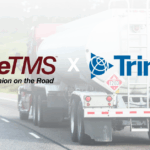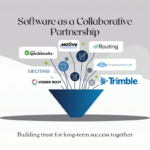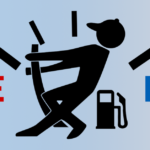Why the next generation of logistics belongs to data-driven, AI-enabled operations, and what it means for carriers stuck in the past.
The logistics industry is undergoing a radical transformation. In just the past few years, the convergence of AI, real-time analytics, and cloud-native technologies has fundamentally changed how supply chains operate. What was once considered cutting-edge, manual dispatch augmented by GPS tracking, is now considered table stakes. The modern era demands more: predictive routing, intelligent commodity assignment, and data-driven decision-making in real time.
And yet, many fleets and logistics providers, especially in specialized sectors like bulk liquid and petroleum hauling, are still operating with legacy systems that can’t keep up. The question is no longer whether your technology-stack needs to evolve, but how quickly can you do it.
The Shift from Reactive to Predictive
Traditional TMS platforms were built for a different world. They were designed to track, not to anticipate; to record, not to recommend. But logistics today is no longer about reacting to yesterday’s events. It’s about predicting tomorrow’s needs.
AI-powered route optimization is one of the clearest examples of this shift. Instead of relying on tribal knowledge or dispatcher instinct to plan routes, AI analyzes countless variables like fuel prices, traffic, delivery windows, vehicle capacities, even weather pattern, to find the most efficient and profitable paths. This isn’t just about shaving off a few miles; it’s about minimizing deadhead, aligning loads with compartment compatibility, and forecasting tank levels to automate the dispatch process before a customer even places an order.
This move toward proactive logistics isn’t a “nice-to-have.” It’s quickly becoming a competitive necessity.
Real-Time Data: The New Currency of Logistics
If AI is the engine, real-time data is the fuel. The speed of business has accelerated, and the ability to make timely, informed decisions is now a defining factor in operational success. Carriers who rely on batch data or end-of-day reports are already at a disadvantage.
Real-time data enables smarter decision-making across the board. It empowers dispatchers to reroute on the fly, gives customer service teams live updates they can pass to clients, and offers operations managers visibility into KPIs as they happen, not after the fact.
But this data is only as powerful as your ability to harness it. The right systems don’t just display data, they interpret it. They detect anomalies, flag inefficiencies, and surface insights that humans might overlook. A modern TMS should act like a co-pilot, not just a digital clipboard.
The Rise of Verticalized Solutions
One of the more interesting trends in the evolution of logistics technology is the move away from one-size-fits-all platforms toward specialized, verticalized solutions. For too long, niche industries like petroleum hauling, cryogenics, and chemical transport have been forced to adapt general-purpose software to fit their complex operational needs.
But as technology becomes more modular and API-driven, we’re seeing the emergence of purpose-built tools for specific challenges. Solutions that understand the nuance of trailer compartments, product compatibility, rack scheduling, and compliance in regulated industries. These systems aren’t just tailored; they’re transformative.
We’ve seen this firsthand with newer platforms built to handle the unique problems of liquid bulk logistics. These solutions aren’t just modern. They’re agile, cloud-native, mobile-friendly, and interoperable with the broader ecosystem of fleet management tools, telematics providers, and data platforms.
Change Management Is the Bottleneck
Interestingly, the biggest obstacle to modernizing logistics isn’t the technology. It’s the culture. Legacy systems persist not because they work well, but because “that’s how it’s always been done.” Dispatchers hesitate to give up manual processes they’ve relied on for years. Executives worry about the risk of switching platforms. Teams fear the learning curve.
But the cost of inaction is no longer just about inefficiency. It’s about falling behind. As competitors adopt smarter systems, gain better visibility, and automate complex processes, they begin to scale in ways that simply aren’t possible on older platforms.
Change management isn’t easy, but it’s essential. The key is starting small: modernize a region, a department, a single process. Prove the value quickly. Then scale. It’s not about flipping a switch. It’s about building a foundation for continuous improvement.
Integration Over Isolation
Another defining feature of the modern logistics stack is integration. Today’s carriers need systems that don’t just operate well on their own…they need to communicate seamlessly with everything else. That means tighter connections with fuel suppliers, customer portals, ELDs, tank monitors, and financial software.
The future is composable: a logistics tech stack that is customizable, API-driven, and interoperable. It’s not about finding one platform that does everything. It’s about building a system of best-in-class tools that work together in real time.
And that’s where modern TMS platforms are headed, moving away from monolithic designs and toward ecosystems.
What Does the Future Look Like?
Looking ahead, we’re likely to see a continued emphasis on automation, not just in routing, but in every facet of the operation. Think automated tank forecasting, smart contract billing, intelligent order batching, and AI-driven load planning that knows which trailer compartments to use based on product type, quantity, and rack availability.
We’ll also see more predictive alerts: systems that notify you of a missed delivery before the customer calls, or flag a recurring compliance risk before it becomes a liability.
And with cloud scalability, even smaller carriers can access these tools. This is leveling the playing field in ways we haven’t seen before.
Are You Ready?
This isn’t about jumping on the latest tech trend. It’s about acknowledging a structural shift in how logistics works, and making the conscious decision to evolve alongside it. The technology is here. The data is flowing. The question is whether your operation is positioned to take advantage of it.
If you’re still using a system built a decade ago to manage the complexities of today’s logistics landscape, it’s time to ask: What’s holding you back?
Maybe it’s fear of disruption. Maybe it’s the inertia of legacy processes. Or maybe it’s just not knowing where to start.
But the longer you wait, the more ground you lose, not just in efficiency, but in competitiveness, scalability, and customer satisfaction.
Final Thought
The logistics leaders of tomorrow won’t just be the ones with the most trucks or the largest fleets. They’ll be the ones who use technology to see more, decide faster, and execute better. Whether you’re a regional carrier or a national fleet, the tools now exist to operate at the speed of modern logistics.
So again, the question: Are you keeping up?



